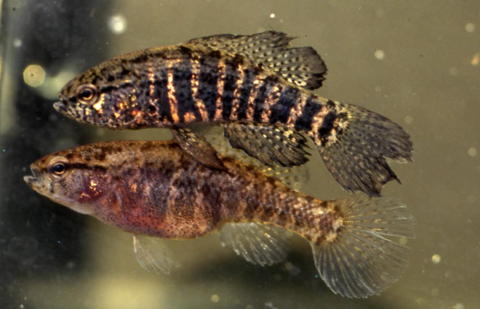
Elassoma zonatum
FAMILY
Elassomatidae
TAXONOMY
Elassoma zonatum Jordan, 1877, Little Red River, Arkansas; R.
Brazos, Texas; United States. No subspecies are recognized.
OTHER COMMON NAMES
German: Gebдnderter Zwergbarsch.
PHYSICAL CHARACTERISTICS
Maximum total length 1.9 in (4.8 cm). White and grayish
black, speckled fish with two stripes on the anterior sides of
the body. One stripe extends from the mouth through the eye,
and the other begins above and behind the eye. Tail and fins
are also speckled.
DISTRIBUTION
South-central United States south of a line from southern Illinois
to North Carolina.
HABITAT
Muddy-bottomed freshwaters, including swamps and other
weedy aquatic areas.
BEHAVIOR
Normally solitary; males in limited space will defend their territories
against encroachment by other males. Territorial displays
include a more intense body coloration, a rapid beating
of the tail and pectoral fins, and if necessary, a quick strike at
the intruder.
FEEDING ECOLOGY AND DIET
Carnivore; feeds on crustaceans, worms, and other invertebrates.
REPRODUCTIVE BIOLOGY
During breeding season, the male takes on brighter coloration
and begins enticing a female to his spawning site by wiggling
all his fins in a distinctive pattern. Once a female appears receptive,
the male trembles and “points” to the site with his
snout, and then gently prods the female. Nest building may or
may not occur, perhaps depending on the suitability of the
substrate. Relatively little is known of its
REPRODUCTIVE BIOLOGY
in the wild.
CONSERVATION STATUS
Not listed by the IUCN.
SIGNIFICANCE TO HUMANS
Of minor importance to the pet trade, also important as indicator
species of environmental quality.
Photo Gallery of - Banded pygmy sunfish





 Animalia Life
Animalia Life